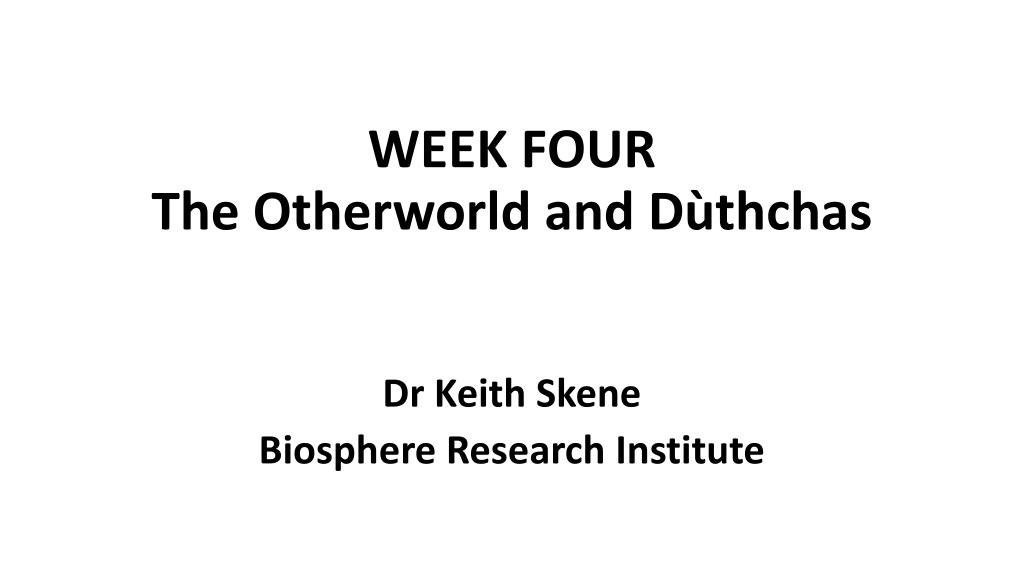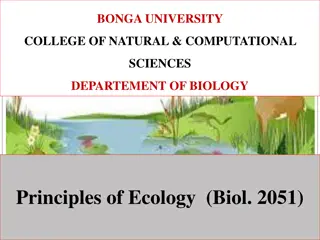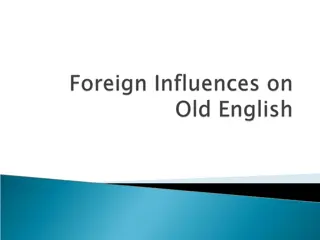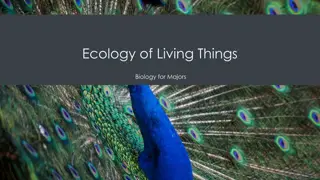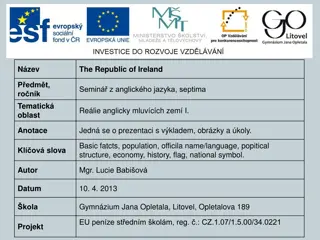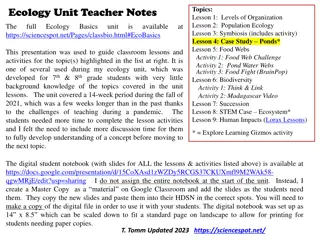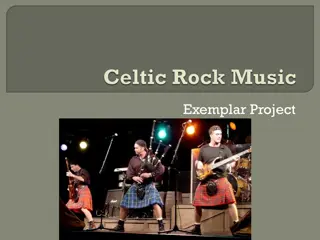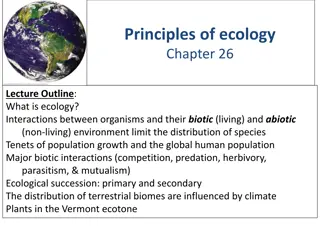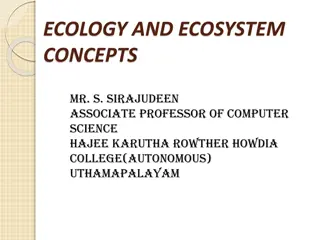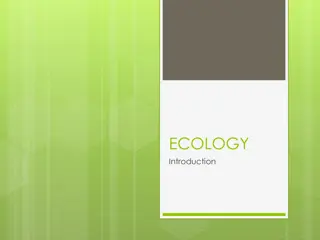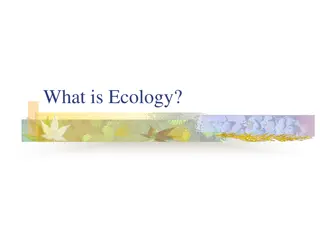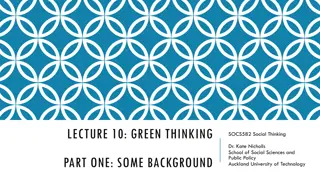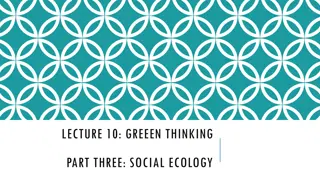Celtic Ecology and the Otherworld
Key elements of Celtic Ecology highlight a shift towards ecocentrism and the integration of the triskelion symbolizing interconnectedness. The Celtic Otherworld is depicted as a realm of powerful ancestors and wisdom, accessed through various portals like Samhain and Beltaine. Communication with this realm is facilitated through poems and songs, offering insight and guidance. Descriptions by scholars and poets portray the Otherworld as a place of perpetual youth and abundance, existing parallel to our world but often imperceptible to many.
Download Presentation

Please find below an Image/Link to download the presentation.
The content on the website is provided AS IS for your information and personal use only. It may not be sold, licensed, or shared on other websites without obtaining consent from the author.If you encounter any issues during the download, it is possible that the publisher has removed the file from their server.
You are allowed to download the files provided on this website for personal or commercial use, subject to the condition that they are used lawfully. All files are the property of their respective owners.
The content on the website is provided AS IS for your information and personal use only. It may not be sold, licensed, or shared on other websites without obtaining consent from the author.
E N D
Presentation Transcript
WEEK FOUR The Otherworld and D thchas Dr Keith Skene Biosphere Research Institute
LECTURE SEVEN THE CELTIC OTHERWORLD
Key elements of Celtic Ecology Multidimensional and complex We see the framing of social dialogue moving beyond the anthropocentric to a place of ecocentrism The integration of the triskelion where everything is within everything and a pluriverse of existence both temporal and spatial exist Akin to yin and yang
Celtic Otherworld Home of powerful ancestors Communication with the otherworld focused on the many portals Samhain, Beltaine, bodies of water, caves, forests, large stones Poems and songs formed the means of communication Wisdom and the precedents of life were found in the Otherworld
Described by Maureen N Bhrolichin as A perfect realisation of this world. A place without death, disease, war and old age The gods, the heroes and the dead lived in a state of perpetual youth A pagan Heaven But much more than that.
The Otherworld Sometimes seen as a parallel universe, reaching into this world as fog or dramatic weather changes Sometimes beyond the Western (Atlantic) seas Or beneath the water Many of the sagas, songs and poems relate tales of voyages or adventures into such a place.
The ancient Otherworld is portrayed often as being around us at all times, yet imperceptible to most people The Voyage of Bran is an example, emphasising the parallel nature and co-existence.
Abundance of Harvest The otherworld is depicted as abundant in food, trees heavily laden with fruit and perfect fields of crops An earthly leader could be judged on the harvest A plentiful harvest meant his relationship with the otherworld was good A famine would indicate otherwise and could lead to the toppling of the leader. Land of the Forever Young by Arthur Rackham, 1920
Nature across both worlds Thus, Nature signalled the integrity of the leader It represented the spiritual as well as the physical And was a bridge across both worlds An entire set of additional dimensions.
Seasonal differences The Otherworld was six months out of sync with the present world So Samhain here would be Bealtaine there And vice versa Visitors in the myths would bring back food from the opposite time of the year, such as summer fruits in Winter.
Thin veils Certain times of the year were looked on as periods when the two worlds came close together At these times the Otherworld could be entered by passing through a hollow hill, especially at liminal times of year such as Samhain and Bealtaine The magical barrier, the F Fiada, is not actively concealing them.
Liminal spaces in cinema The Shining (1980)
F fada This magical mist could render people invisible or appear as animals Again, here, nature would take on a greater significance Druids and the Tuatha D Danann could control it
Tuatha D Danann The folk of the Goddess Danu Early invaders who took control of Ireland Supernatural beings
The Riders of the Sidhe, by John Duncan (1911), McManus Art Gallery, Dundee.
John Duncan (1866-1945) Born in Hilltown, Dundee Studied at Dundee School of Art (Dundee High School) he would work with Patrick Geddes and became a major artist in the Celtic Revival. The Riders of the Sidhe used egg tempera techniques John Duncan s daughter Binty recalled: Not only did the house stink but we ate meringues for breakfast, lunch and dinner.
Tuatha D Danann and the Fomerians Tuatha D Danann, the earliest people of Ireland with magical powers, were adopted as fallen angels in medieval Christian writing, not all bad or all good The Fomerians, their enemy, represented the destructive forces of nature Here again, nature takes on multiple representations, integrating the natural and supernatural world.
Chaos and Order Chaos creates order Order creates chaos An energetic Yin and Yang
Incantations of protection Gave 24 hours of protection Magical, empowering spells Would later be adopted into Christianity For example the Breastplate of St Patrick, or the Deer s Cry A fascinating crossover between Pre-Christian and Early Christian beliefs Emphasis on today throughout the prayer.
Adopted Incantations This power would be adopted by Christianity, applying to the saints In the celebrated prayer-poem The Deer's Cry attributed to St Patrick the Saint turns himself and his companion, St Ben n, into wild deer on their way to evangelize Tara The enemies who wished to ambush them saw only a deer with a fawn.
The double motif of transformation and invisibility is also present in the Middle Irish Life of Patrick According to this text, Patrick s blessing calls forth a d cheltair, a covering, concealment, disguise, invisibility, an invisibility spell.
The Coligny Calendar A fragmentary bronze inscription found at Charmoux near Coligny, France, outlines winter and summer holy days on a combined 62- month lunar and solar calendar
Dating back to 50 BC A bronze plaque, some five feet by four feet, it was a significant structure Deliberately destroyed, likely by the romans Cut into many small fragments and buried along with a destroyed statue, likely of Lugus (Lugh)
Rediscovered, in 1897, by a Monsieur Roux Sixty percent of the original structure has been recovered (around 150 fragments) A lunisolar calendar
Details of the Calendar 12 months of 29 or 30 days, with a leap year every four years Each month divided into full or new moon phases (15 days of each) The four great Celtic festivals are marked on it Samhain, Imbolc, Bealtaine and Lughnasadh Linguistic similarities between Irish Gaelic and Gaulish writing on the calendar.
A similar fragment had been found in the waters of a stream feeding into the Lac d' Antre, at Villards d'Heria in the Jura, in 1807
Irish Sam end of summer Samhain festival Irish gam end of winter Irish: Eid - fire
Coligny evidence of proto-celtic? Dr Cathy Swift: Linguistic similarities point towards a pan- celtic linguistic identity *see reading list Gaulish and early Irish share a vocabulary Major challenge to the Celto-sceptics
Samhain (Sow-n) The Celtic New Year Fervent dancing and sacrificing marked the Samhain festival in November each year, the gateway from Summer to Winter in the Druidic tradition In Scotland, farmhands would run around farm boundaries carrying flaming torches to drive evil spirits away as this gateway marked the period closest to the otherworld.
the first day of November This date is also important in many other cultures, commemorated in various ways as the Day of the Dead (D a de los Muertos) and Hallowe en, the Christian Church adopted this day as All Saints Day.
Cailleach, Ruler of Winter Cailleach was the despotic ruler of wintertime, reigning from Samhain (the first day of November) to Bealtaine (the first day of May) As her time came to an end, she transformed into a moist rock until her awakening the following Samhain Brid took over as Queen of summer
Scottish tradition On the night of Samhain, Cailleach captures Brid, Queen of Summer, in a cave in Ben Nevis Her own son, Angus, frees Brid in the spring and they reign together as King and Queen of summer until Cailleach captures Brid again, in a cycle of seasons, imprisoning and liberation.
Most of Nature hibernates but will it awaken? The coming winter is heralded by Nature It s significance operates fundamentally across all of the Celtic ecology and spirituality No guarantees: Younger Dryas ice age in oral memory
Imbolc (im-elg) Ewe s Milk St Bridget s Day, 1st February Halfway point between Winter solstice and Spring Equinox Marked the beginning of the agricultural year And the end of winter Christian equivalent is Candlemas - the presentation of the Christ child at the temple in Jerusalem, forty days after his birth. Both linked with light
The Gaelic goddess Bridget or Brid Goddess of poetry, healing and craftsmanship and of motherhood, passion and fire A Triple Goddess: Maiden Inspiration and poetry Mother Midwife and healer Crone Hearth fires, smithies and crafts
Imbolc Clooties
Celtic traditions at Imbolc People spent time watching hedgehogs (to see one was a good weather sign), Preparing and eating special food Making straw girdles and caps.
Imbolc celebrations Putting red ribbons on their houses ( Brigit s cloak ), making special Brigit s crosses and straw dolls, called Brideog, Visiting sacred springs (prohibited by St. Patrick), and singing protective charms, often lasting for 24 hours.
Hedgehogs, bears and Groundhogs All associated with weather forecasting If seen, it meant a good spring ahead Groundhog day 2nd February Festa della Candelora (Bears in Italy ) 2nd February
Bad weather augured well Cailleach would make Brid s day a sunny one To allow her to gather fire wood, and live longer, delaying spring
Bealtaine (Byel-tin-uh) Early May The beginning of summer The second close proximity between the world and the otherworld A major portal More fire!
Important marker for farming Onset of mackerel season Turf cutting began Cattle neutering Transhumance (cattle moved to pasture) Fear of disease and theft of health and luck, from Otherworld, and of changelings
Changelings Babies taken to serve fairies and swapped with old fairies who needed caring for!
The terrible fate of Bridget Cleary Her husband, Micheal, claimed she had been swapped for a changeling And murdered her by immolation in 1895 An Irish nursery rhyme reads, "Are you a witch, or are you a fairy Or are you the wife of Michael Cleary?"
Sacrifices at Beltaine Whole herds of cattle would be sacrificed and their blood burned Centred around Cruachan, ancient capital of Connemara and the Cave of Cruachan, gateway to the otherworld
